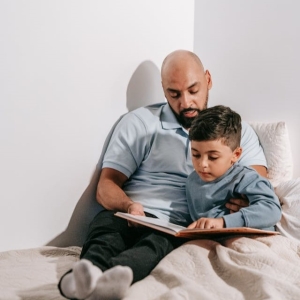Summer tips for parents: social stories
Summer is here! With the arrival of warmer weather and the end of the school year, it can be an exciting time for families. The summer season also brings many changes, including new schedules, routines, experiences and expectations. For families with autistic children, it can be challenging to balance summer fun while reducing the stress of an unpredictable schedule and unfamiliar environments. Your ACT SLPs have put together some tips to support an enjoyable and low-stress summer break.
Preparing for New Experiences & Environments
Many families incorporate activities such as camps, vacations or play dates during the summer months. New people, experiences and environments can be stressful for all children, particularly those with autism. Social stories can be a helpful tool to prepare your child when getting ready to try something new.
The use of social stories can greatly decrease anxiety for the autistic person who is facing a new situation. There are several websites with pre-made social stories on a variety of topics. For anyone interested in creating their own customized social stories, you can also reach out to your therapy specialists for ideas on details to include and appropriate wording. Depending on the topic, you may wish to include personal/real photographs (e.g., a picture of the room or building your child will be visiting for the first time). Drawings or illustrations can also work for social stories.
Tips for Creating Meaningful Social Stories (adapted from Carol Gray, 2014):
- Identify the specific topic and the goal of the social story. For example, “Going to Basketball camp” or “Flying on an Airplane”. The goal of social stories should be to increase understanding of a new concept, skill or situation.
- Use appropriate language. Ensure that the vocabulary and style of writing are appropriate for the age and communication skills of the person for whom you are creating the story. You may want the story to be written in first person (using “I”) or third person perspective (i.e., “he”, “she”, “they” etc.).
- Ensure a positive tone. Social stories should be supportive and encouraging with the goal of sharing information rather than coaching or directing the person for whom it is intended. Focus the story on what to do, rather than what not to do. For example, say “On the bus, I sit in my seat” rather than saying “I don’t run on the bus”.
- Use the WH-questions to guide you. After introducing the topic of the story, use the main part of the story to answer the important “who”, “what?”, “when”, “where”, “why” and “how” questions. For example, a social story for visiting the Zoo might include:
- Who: with my family
- What: walking together to look at animals
- When: Sunday morning
- Where: the specific zoo
- How: staying close, holding Dad’s hand, looking with my eyes, etc.
- Stay relevant. Include only the most pertinent information and ensure that the story is an appropriate length for the attention and abilities of the person you will be reading it with. This may mean only a few pages for early-stage communicators.
- Review the social story with your child before the event takes place, ideally several times (e.g., read a “What I do at the Zoo” story each day for the week before you go to the Zoo and before leaving the day of the event).
Maintaining Structure
Without the daily routine families are accustomed to during the school year, it can be tough to maintain a sense of structure throughout the summer break. Visual schedules can help your child understand their new summer routine, which may help lower their anxiety and support their participation. Try to include some consistent daily activities (such as ‘brush teeth’ or ‘bedtime’) as well as new events (such as ‘go to Grandma’s’ or ‘Camp’). Your visual schedule does not need to include specific times. Rather, the important thing is to present the information in a way that suits your child’s understanding. For example, you might include written labels and pictures or photos. You might include times where your child can choose which activity they want to do or indicate when there will be a break for “free time”. Review the visual schedule with your child to help them understand what to expect during their day.
Prioritize Mental Health and Regulation
During summer break, some parents may feel pressure to enroll their children in additional activities or therapies or try to keep up a structured routine at home. While this might work well for some families, caregiver burnout is also something to watch out for. To prevent additional stress on caregivers and children, focus on supporting sensory needs for regulation and ensuring that regular access to preferred methods of communication is available. Whether you are at home or out in the community, there are steps you can take to ensure both you and your children can regulate throughout the day and can continue to communicate. It may be helpful to create a quiet and cooling space at home that your child can go to when they need a break. This might include a darker room, a play tent or a cozy blanket fort with a fan and sensory equipment or comfort items. When leaving the house, try to ensure your child has access to a preferred snack and a cold drink, as well as any portable sensory equipment (such as headphones or chewelry) and/or comfort items. If your child uses visuals to communicate, having copies at the different places they will visit, or one in the car, can ensure they have access to their words wherever they go. Don’t forget to keep AAC devices charged and ready to take on the road. It may be helpful to speak to your therapy team for other ideas on how to support the individual needs of your child in the summer months, or to update their communication devices to reflect the vocabulary needed for their new routines and environments. Remember that it’s okay to take breaks – this goes for caregivers and children!
Whether you plan to be out and about or stay home and relax this summer, there are several ways you can help make the summer break as fun and stress-free as possible for everyone.
References:
https://worldstemcellsclinic.com/blog/autism-and-summer-tips-to-overcome-summer-challenges/
https://learnbehavioral.com/blog/7-tips-for-creating-summer-fun-for-autistic-kids
https://behaviorexchange.com/blog/summer-safety-tips-for-families-of-children-with-autism/
https://carolgraysocialstories.com/social-stories/what-is-it/
chrome-extension://efaidnbmnnnibpcajpcglclefindmkaj/https://carolgraysocialstories.com/wp-content/uploads/2015/09/Social-Stories-10.0-10.2-Comparison-Chart.pdf
https://cultivatebhe.com/tips-for-summer-traveling-with-children-with-autism-a-parents-guide/



